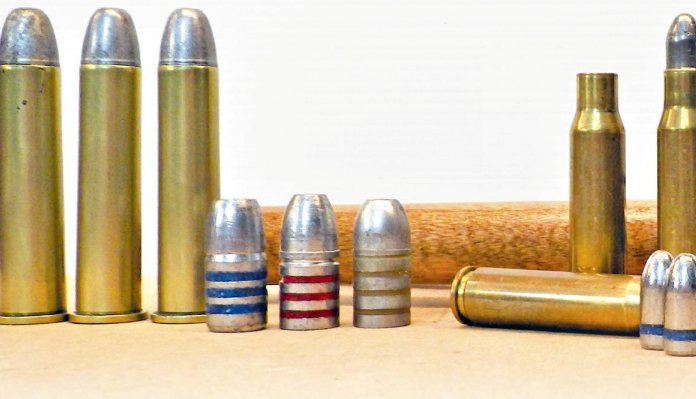Reloading Basics - reloading with lead bullets
-
0
 Comments
Comments
- Last updated: 15/12/2022

Although most people that reload centrefire rifle ammunition tend to do so with jacketed bullets, there are still some occasions where plain lead bullets are used, including for cowboy action shooting with underlever rifles or plinking rounds for practice. Although the equipment is pretty much the same when reloading with lead bullets, it does require a slightly different approach.
When referring to lead bullets we actually mean lead-alloy, because pure lead would be too soft to use in all but black powder shooting. The lead is usually mixed with other metals such as antimony and tin, which harden it significantly and improve the way it flows and fills the bullet mould. If you are buying bullets, rather than casting your own, you can generally assume that they are hard enough for their intended purpose.
Not having the protection of a copper jacket, the base of the lead bullet will be exposed to the direct heat and pressure generated when the powder charge is ignited in the chamber. This could actually melt the base of the bullet and so the powder type and charge have to be considered carefully and reloading data followed closely.
Because lead bullets are that much softer, they can be more easily damaged during reloading. This most commonly happens when the bullets are being seated, as they are pushed into the case past the sharp edge of the mouth. If the bullet-to-case-mouth fit is not right, then the sharp edge of the brass can dig into the lead and gouge the side of the bullet. If this happens, you will see a part of the bullet on the outside of the case. Both case and bullet will be ruined and the round should not be fired.
Often lead bullets will have a bevelled base, where the rim of the base is rounded off to some degree, and this helps stop the cases damaging the bullets and also helps you seat them straight.
To prevent bullets from being damaged while they are being seated, it is often necessary to open the case mouths up slightly using an expander die. These dies use a ‘plug’ that is calibre specific, and they are designed to open up the case mouth very slightly and effectively form a bell shape at the rim. Once the bullet is seated, you will need to remove the flare you have put on the case and close the mouth back down. This is done with either a bullet seater die or with a crimp die. If your bullet seater die is also designed to apply a crimp, you can adjust it down to remove the case flare as you seat the bullets. The alternative is to use a specific crimp die to do the job. These dies are designed to apply a tightening to the case mouth, to increase the grip the case has on the bullet, but they also function to remove the flare. Care is needed to adjust these dies correctly because if you apply too much closing force to the case mouths, then you can actually increase the case’s hold on the bullet to a point where it will significantly increase the chamber pressure required to release it. All you want to do is remove the flare you applied, and a good way of checking this is to measure the diameter of an unflared case mouth, with a calliper, and then measure it again after the flare has been removed.
When the bullet is driven out of the chamber and into the rifling of the barrel, it is subjected to huge pressure and temperature spikes and both can damage a soft bullet. If the surface of a lead bullet melts in the barrel, it will cause excessive leading in the rifling and be so badly damaged that accuracy will be compromised. The base of the bullet can be melted by the heat of the gases behind it and the sides can be melted by the friction between it and the surface of the bore. It is therefore very important to ensure that when reloading with lead bullets, you only use published reloading data that is suitable for your bullet. You cannot simply substitute a lead bullet for a jacketed one and use the same data. Jacketed and solid copper bullets can resist much higher temperatures than exposed lead. There are lead bullets with copper gas checks on the base, which are small copper disks crimped onto the lead to protect it from the heat, and these bullets can better withstand the temperature and pressure they are subjected to.
Using lead bullets, in place of jacketed, is a great way to practice and save money. A suitably reduced load in your chosen calibre, behind a lead bullet, can often be used on smaller ranges and at shorter distances safely, and this allows you to get more trigger time without the cost of using your far more expensive copper-jacketed rounds.
In .308 Winchester, the GM Hardcast 115-grain .309 diameter bullet can be loaded over some Alliant Unique. If done correctly, the chamber pressure and muzzle velocity are well within safe limits. This is a great practice round and, over relatively short distances, it is a good choice.
There are loads for lead bullets published by many powder manufacturers and they are well worth a try. In certain calibres, loads for ‘Cowboy Shooting’ are published and these are specifically for lead bullets at lower velocities. Reloading software can also be used to check the viability and safety of a particular load and QuickLOAD contains plenty of lead bullets, including all of those that you can cast yourself with Lee Precision moulds, so you can develop a safe lead-bullet load to suit your gun. Approached carefully, switching to a lead bullet is well worth a try.
QuickLOAD – www.quickload.co.uk
